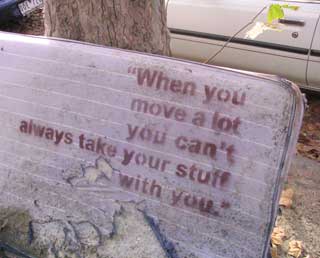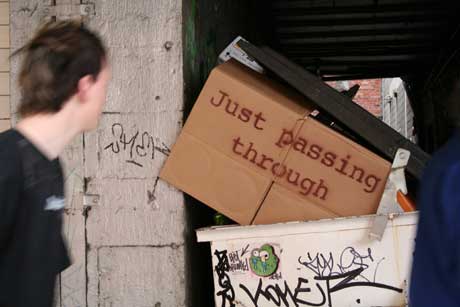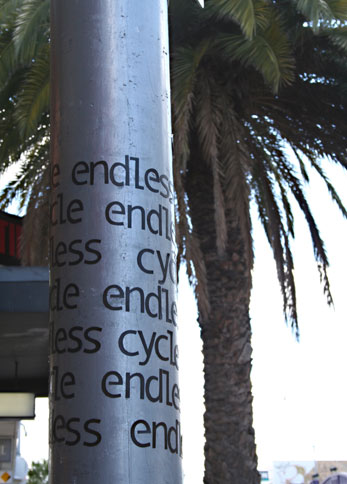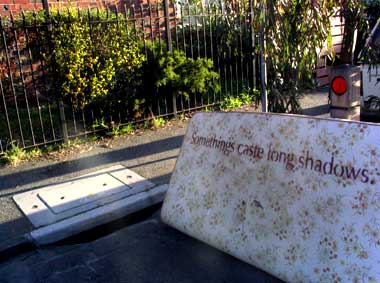
(dis)owned
is a series of text work manifests in three different forms: text stencilled onto discarded furniture (discarded) and cardboard boxes (boxed-in) and a series of words made from magnetic material and wrapped around metal lamp posts (postings)
These temporary interventions refer to stencil art and graffiti but without imposing an indelible mark on public or private property. In this sense it is also subverts the very nature of graffiti. Unlike graffiti the letters wrapped around the lamp posts can be re-ordered or removed by the audience and dumped furniture becomes a new kind of public space, (dis)owned by all.
The work also mimics the conventions of advertising by using computer generated text and inserted into public places. The fonts suggest corporate branding and it only at a second glance that the content emerges. These interventions hopefully disrupt to the viewer’s acceptance of commercial interests as ‘ordinary’ in the natural order of the urban landscape.

‘boxed-in’
is ephemeral work placed in skips or with piles of flattened cardboard stacked for collection every afternoon on the streets of the city. The work may only stay in the public space for a matter of hours, but is on view to thousands of passers by. Then it becomes just another item to be discarded. Boxed-in is a representation of our consumer society and the assumptions we make about the disposability of things and people. Cardboard boxes are the canvas. Boxes are ubiquitous containers, protecting the goods we buy, then disposed of with little thought to be recycled into yet another round of packaging. They are also useful material for the resourceful gleaner; temporary shelter for a night on the streets, a sign to document a hard-luck story, requesting a few coins for a meal or a coffee or a bed: signs that nobody reads properly.
The first work in this series ‘Just passing through’, comes from the ideas of Darko Radovic (Head of Urban Planning at Melbourne University) who talks about urbanity and the responsibility we have to maintain the urban (and social) fabric for those who follow. He reminds us that we only inhabit a place on a temporary basis: caretakers, not owners. But the statement is open to many interpretations: the laconic lament of the swaggie, the shallow gaze of the global backpacker, the dismissive arrogance of the corporate executive.
For more BOXED-IN click here
‘postings’
consists of a set of phrases such as ‘endless cycle’, ‘full circle’ and ‘vicious circle’. The individual letters are cut out of magnetic sheets and assembled on metal lampposts and fire hydrants.

Sometimes the words are repeated over and over again in a downward or upward spiral. In the St Kilda context the text suggests the changes in Acland St – a fruit shop becomes a bag shop then a juice bar which becomes a cafe – and then back again to a bag shop. It is also about the endless cycles of poverty and disadvantage in the area. Johnny, one of the street’s local identities endlessly drinks, gets pissed, runs out of grog and then asks for money and starts all over again.

In the city of Melbourne the words are more open to interpretation. The combination of location and text provide some clues. Another element of the project is that the viewer can very easily rework the text, to make new words or transform the letters into decorative patterns.
For more POSTINGS click here

‘discarded’
is a series of quotes and stories stencilled onto abandoned furniture, found in copious quantities in St Kilda. They include works on old mattresses wardrobes, fridges, chairs and couches. The mattress, however, is the most compelling canvas because of what it symbolises of the Melbourne suburb St Kilda. It represents consumption, itinerancy, homelessness, sex, love, dreaming, abuse etc, all ideas I am exploring in this project.
While short, each story is open to multiple interpretations, which are generated by the combination of text and site. Generally the voice in the story is inclusive and is sharing an experience or giving advice by using the second person pronoun (you) as the subject in every story. It is a vernacular style that people often use to distance themselves from their painful experiences but also allows many different points of view.
If people don’t like the works they can call the council and get them carted away. The objects may stay in situ anywhere between two days and three weeks. In this sense discarded is spontaneous, democratic and mysterious and makes use of the context of the urban space.
For more of DISCARDED click here
